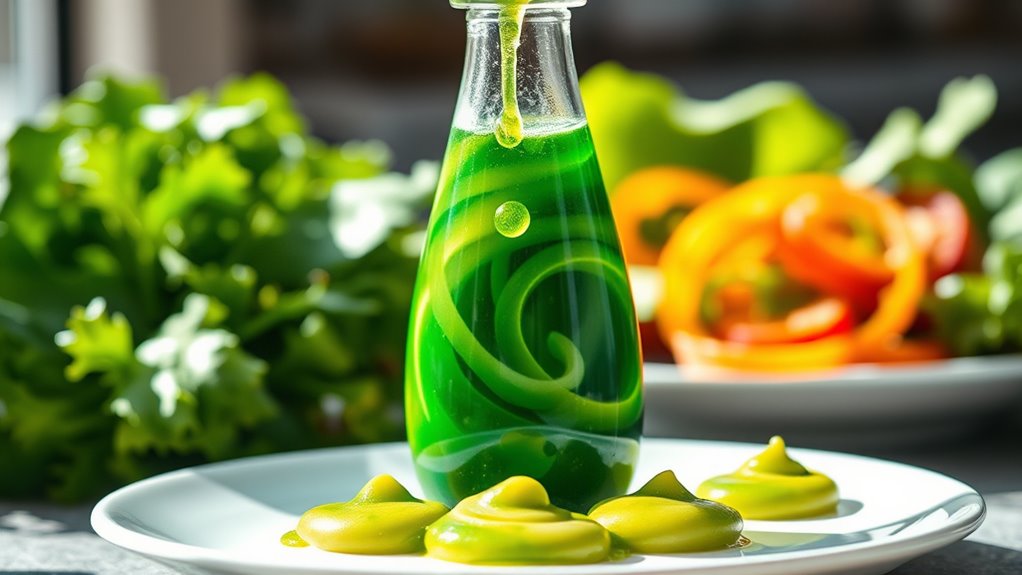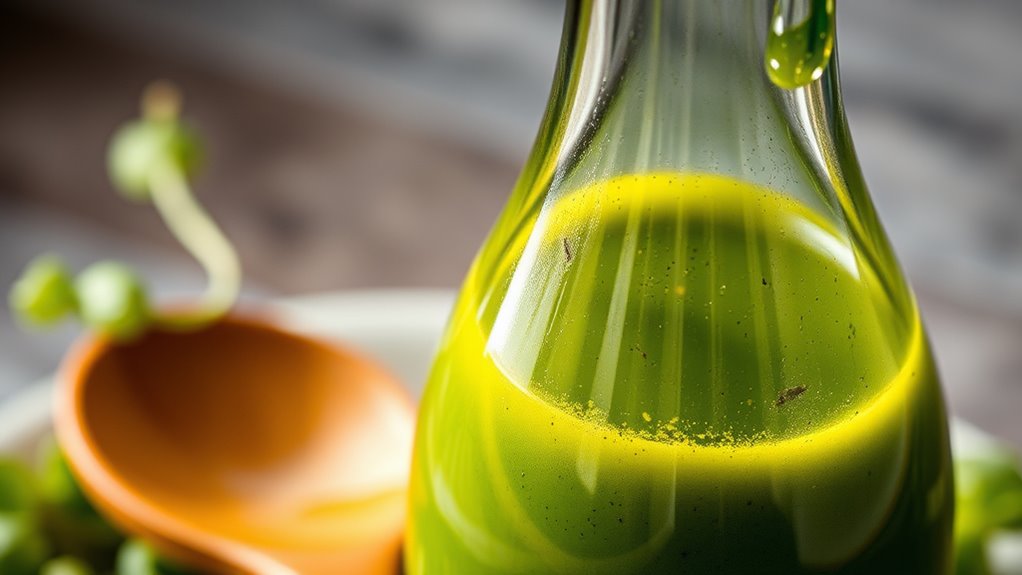Whip up a silky, bottle-friendly salad dressing in minutes with a simple blend of 3/4 cup extra-virgin olive oil, 2 tbsp white wine vinegar, 1 tbsp lemon juice, 1 tsp Dijon, a small minced garlic clove, 1/2 tsp honey, plus a pinch of salt and pepper. Whisk until cohesive, then emulsify in a bottle with a quick shake. It’s bright, smooth, and ready to cap every greens coat—about to spark even more flavor ideas.
Ingredients and Quantity

To make a tasty dressing, start with the core ingredients and their measured amounts: 3/4 cup extra-virgin olive oil, 2 tablespoons white wine vinegar, 1 tablespoon lemon juice, 1 teaspoon Dijon mustard, 1 small clove garlic (minced), 1/2 teaspoon honey or to taste, and a pinch of salt and black pepper.
Flavor combinations bloom when you respect balance: oil carries, acid sharpens, sweetness rounds, and mustard binds. Ingredient substitutions keep your freedom intact—use apple cider vinegar for fruitiness, maple syrup for depth, or Dijon alternatives like grainy mustard for texture.
| Component | Quantity | Notes |
|---|---|---|
| Oil | 3/4 cup | Extra-virgin, cold-pressed |
| Acid | 3 tbsp | Vinegar/lemon mix |
| Flavor | 1 tsp | Mustard, garlic, seasoning |
Preparations

Preparing the dressing is quick: whisk the oil, vinegar, lemon juice, and mustard in a bowl until they gleam together, then fold in the minced garlic, honey, salt, and pepper. You’ll sense the first bright notes bloom as sweetness rounds acidity. Swirl in a splash of water if you crave lightness, or add a pinch of herb salt for green aroma. Emulsify steadily until the surface looks satin and cohesive, not separate. Taste, adjust, and consider dressing variations you might explore: a tangy citrus punch, a creamy finish with yogurt, or a sesame-soy depth for an Asian zest. Each tweak reveals flavor profiles that empower you to tailor salads to mood, occasion, and appetite. You’ll know exactly how to balance brightness, body, and bite.
Kitchen tools or Kitchenware Required

You’ll reach for a few trusty tools that make dressing a breeze: a medium bowl for whisking, a whisk or fork that fits comfortably in your grip, and a measuring spoon or small cup for the honey and lemon juice. This simple kit keeps you in control, letting flavors mingle with ease. You might reach for a Salad shaker to emulsify with a confident shake, smoothing texture as oils and acids unite. Measuring spoons stay precise, preserving balance with every pinch. The right toolset feels liberating, turning routine into ritual. Accessories like a small spatula assist clean transfer, while a sturdy apron keeps freedom unfettered. Table below adds a refined touch to your tool philosophy.
| Tool | Purpose |
|---|---|
| Salad shaker | Emulsifies dressing |
| Measuring spoons | Precise portions |
How to Cook

- Whisk together your chosen ingredients, allowing their scents to rise and mingle.
- Measure, pour, and taste along the way without heating anything—just combine and balance.
- Feel the tang meet the sweet, the sharp meet the smooth, adjusting with a quick whisk or a cautious splash.
- Notice salad variations as you shift ratios: more citrus for brightness, more oil for silkiness, or a touch of honey for warmth.
- Taste as you go, documenting how each tweak changes the dressing flavors.
- Keep it crisp and honest: respect the ingredients and let color guide you.
- Embrace freedom in simple decisions rather than strict recipes—trust your palate, refine, and savor the dressing you’ve crafted.
How to Serve

How you plate and pair your dressing with greens can elevate a simple bowl into something memorable. You’re steering the vibe with color, texture, and a confident drizzle that glistens like morning dew. Aim for balance: bright greens, crisp add-ins, a kiss of tart or sweet, and a final, intentional finish. Use clean plates that frame the salad, letting the dressing draw the eye.
- presentation ideas that spotlight contrast and rhythm
- serving suggestions that honor texture and temperature
- a light, even coating rather than a pool
- dollops or ribbons for artistry, not excess
- bite-by-bite harmony and invited sampling
Keep it simple, expressive, and liberating—your bowl, your rules.
Tips
Salad dressing is all about small, smart choices that pay off at every bite. You’ll learn quick tips to keep the bottle simple and the results striking. Shake thoughtfully; a minute of mixing can bloom texture and aroma you’ll notice with the first drizzle. Taste as you go, adjusting salt, acid, and sweetness to your mood and mood of the greens. For homemade dressings, rinse citrus zest over the bowl to wake oils and brightness. Use a steady whisk or a tight jar shake to avoid separation, then rest briefly to let flavors marry. Explore flavor variations with herbs, roasted garlic, or a touch of Dijon. These ideas invite freedom, while keeping your kitchen creative and confident.
Food Value and Benefit
A well-prepared salad dressing does more than add flavor; it enhances the overall nutritional value of your meal and promotes better health. By incorporating nutrient-rich ingredients, this dressing helps your body absorb essential vitamins and minerals from leafy greens more effectively. Enjoy a vibrant texture and satisfying mouthfeel while reaping the benefits of balanced fats and natural antioxidants.
This recipe contains important vitamins such as Vitamin A, Vitamin C, and Vitamin K, along with minerals like potassium, magnesium, and iron. These nutrients support immune function, bone health, and energy metabolism.
Benefits of eating this salad dressing recipe include:
- Enhanced absorption of fat-soluble vitamins (A, D, E, K) from greens
- Healthy fats that promote satiety and support heart health
- Rich in antioxidants and anti-inflammatory compounds that protect cells
- Supports balanced blood sugar levels with wholesome ingredients
- Low-calorie, nutrient-dense flavor that complements weight management goals
- Contributes to improved digestion and mineral uptake for overall wellness
Frequently Asked Questions
How Long Does Dressing Last After Opening the Bottle?
Dressing lasts about a few weeks after opening, depending on ingredients; typically 1–2 months for shelf-stable varieties in the fridge. Shelf life varies—check best-by dates. Storage tips: seal tight, keep cold, avoid contamination, smell before use.
Can This Dressing Be Made Dairy-Free or Vegan?
Yes, you can make it dairy-free or vegan. Try dairy alternatives like almond milk or olive oil emulsions, and use vegan options such as soy yogurt or cashew cream for creamy texture, while preserving flavor and freedom.
What Substitutions Work Best for Gluten-Free Diets?
Yes—go with gluten free alternatives like tamari, olive oil, lemon, and honey or maple for a simple zing. You’ll savor healthy substitutes that let you flavor freely, avoiding gluten while keeping texture and brightness in every bite.
Is It Suitable for Air-Dry or Cold Salads Only?
Yes, it’s suitable for air-dry or cold salads. You’ll notice suitable ingredients meld smoothly, boosting dressing versatility. You’ll feel bright, fresh flavors, the texture cling, and you’ll taste freedom in every crisp bite.
Can I Scale the Recipe for Large Gatherings Easily?
Scaling recipes for large gatherings is totally doable, you’ll just multiply ingredients and adjust mixing. You’ll taste as you go, feel the textures bloom, and savor freedom as you build a confidently bold dressing scaled for everyone.
